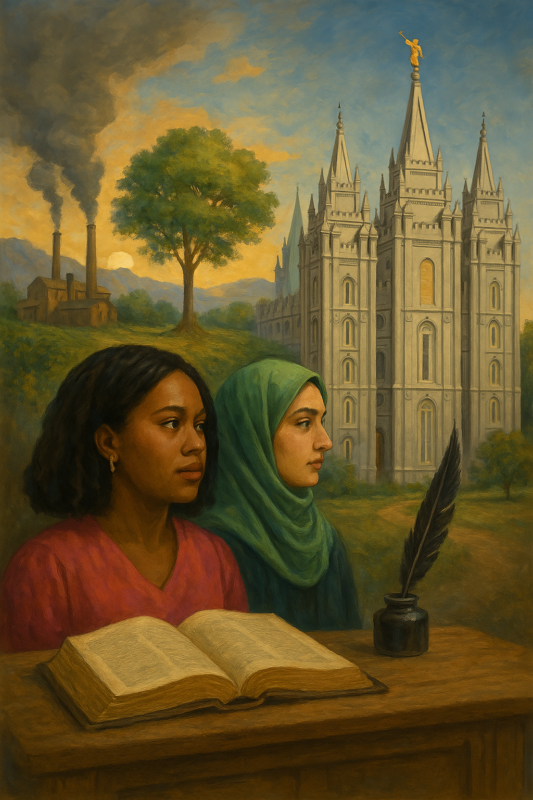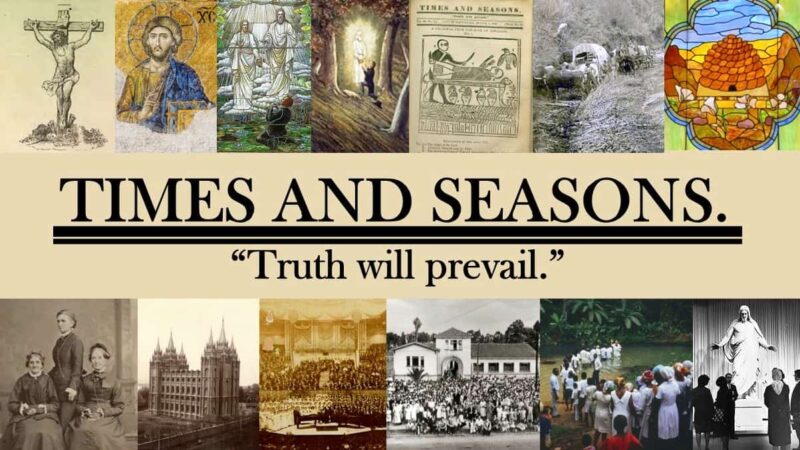
Hahne, Madeleine Ary. “Factors Influencing Climate Change Beliefs among American Latter-Day Saints.” Worldviews: Global Religions, Culture, and Ecology 29, no. 1 (2025): 19-48.
Researchers are increasingly recognizing the salience of religious reasoning to understanding climate (in)action. Most analyses of this topic focus on Western Christianity, particularly American Protestant denominations. As such, little research has been conducted on climate change and American Latter-day Saints (lds or Mormon). This review uses the available research to explore what we know about climate and environmental belief among American Latter-day Saints. As the literature demonstrates, there are numerous “green” aspects of lds theology, some of which are shared in common with other branches of Western Christianity and others which are particular to the faith. In spite of this theology, evidence suggests that Latter-day Saints are among the least likely American religious groups to act in a pro-environmental manner or to prioritize climate change. This review synthesizes the various ways academics have sought to understand this apparent contradiction.
Green, Jonathan. ““Lutius Gratiano” and the Uses of Prophecies.” Journal of Mormon History 51, no. 2 (2025): 96-137.
First paragraph.
Among pseudonymous Mormon prophecies, the one known as “Lutius Gratiano” stands out both for its long popularity and for its disrepute. The prophecy is usually regarded as an 1893 fabrication by Jacob Spori with no basis in the writings of its putative author, the eighteenth-century Swiss pastor Samuel Lutz, that was popularized by LDS missionaries but is significant today only as an example of believers’ unlimited credulity. In the following, I will show that each point is wrong or subject to substantial revision. The specific context in which Spori cited the prophecy of “Lutius Gratiano” has been overlooked, and what Spori meant by the citation has been misunderstood. While “Lutius Gratiano” is a highly selective and exaggerated representation of Samuel Lutz’s writings, it reflects both authentic aspects of Lutz’s views and specific passages in his published works. (See Jonathan’s post about his article here.)
Mohrman, K., and Mia Fischer. “” As-Salaam-Alaikum, Bitches!”: The Biopolitics of Secularism, Neoliberal Multiculturalism, and The Real Housewives of Salt Lake City.” American Quarterly 77, no. 1 (2025): 105-131.
Abstract. Based on an analysis of The Real Housewives of Salt Lake City (RHOSLC), we examine the role that secularism, as a biopolitical discourse, plays in rationalizing and entrenching racial capitalism through the cultural technology of reality television. We illuminate how secularism is interwoven in contemporary discourses of race, gender, sexuality, and class (e.g., post-race, postfeminism, sexual liberation, and spiritual neoliberalism), functioning as a key feature of neoliberal multiculturalism. Specific attention is paid to the complex, contradictory relational racialization of religions on the series, particularly between Mormonism and Islam, as well as to the desecularization of the housewives of color, often through reference to gender and sexual norms. Such representational strategies construct diversity as fundamental to neoliberalism while masking the maintenance of white dominance. In illustrating how contemporary processes of racialization are intrinsically intertwined with (de)secularization on the series, we encourage broader and more sustained attention to religion among critical scholars.
Robison, Elwin C. “Obediah Taylor and the Salt Lake City Assembly Hall.” Journal of Mormon History 51, no. 2 (2025): 65-95.
No abstract. First paragraph: Obediah Taylor Jr.’s Assembly Hall in Salt Lake City, Utah, is an innovative and sophisticated combination of the Gothic and Italianate styles1 (Figure 1). Although it was built thousands of miles away from the eastern cities that were the cultural centers of the day, the Assembly Hall eclipsed contemporary architectural designs through its fusion of styles and complex manipulation of architectural forms. It also altered the typical pattern of tabernacle design in the Utah Territory. Designed in 1877 just as the Italianate style was making its debut in Utah residences, the Assembly Hall combines motifs from architectural pattern books and contemporary buildings in unparalleled ways in late nineteenth-century American buildings. Taylor’s death before the dedication of the Assembly Hall, the relative isolation of the Utah Territory, and changing architectural tastes have contributed to its low profile on the American architectural scene.
Spears, Robyn Shahan. “The Ann Dawson Letter: The Only Extant Document by the First Female Baptized in Europe.” Journal of Mormon History 51, no. 2 (2025): 138-146.
First paragraph.
On November 10, 1840, Ann Dawson, a recent convert to the Church of Jesus Christ of Latter-day Saints in Preston, England, wrote to apostle George A. Smith. The letter is significant for several reasons. It is the only extant document written by Dawson and provides a unique window into the relationship between missionaries and early converts in the British Isles. Moreover, Dawson identifies herself within the letter as “the first Female that was baptised in this Land,” offering firsthand testimony that helps clarify what has long been a debate over who holds claim to that honor. To understand the full significance of the only extant document by the first woman baptized in Europe, historians must first look to the first decades of Dawson’s unheralded life. She lived in Preston, where they labored alongside their eight children in the cotton mills. They moved more than five times until they were ultimately
Orsi, Robert A. “Sexualized Religion/Sanctified Sexuality: Religion and Sexuality Out of the Sacred Closet.” Journal of Mormon History 51, no. 2 (2025): 23-36.
First paragraph.
Of all the polarities around which the modern study of religion is organized—text/practice, rational/emotional, private/public, and so on—the most resilient and enduring has been the good/bad religion binary. This is so even after many decades of critical self-scrutiny in the field of religious studies. Who ought to know this better than we scholars of Catholicism and Mormonism do? The religions we study have been repeatedly framed, separately and sometimes together in malicious comparison, as paradigmatically bad religions. Both have functioned, at different times, as essential religious others in the making of the normative category “modern,” as in “modern American religion.” By modern religion, here and throughout, I mean “religion” as understood and advanced by modernizing elites, including academics, in the United States and around the world, in the seventeenth through the twentieth and twenty-first centuries. “Religion” in this normative sense is circumscribed and disciplined; it exists within the limits…
Howlett, David J. “Faith in Small Things: The RLDS Church, the New Left, and the Global 1970s.” Journal of Mormon History 51, no. 2 (2025): 1-22.
First paragraph.
In May 1991, an editor of the official magazine of the Reorganized Church of Jesus Christ of Latter Day Saints reflected on a tumultuous quarter-century of liberalization within her church. She did so with a feature article previewed on the magazine’s cover with the lines, “Framers remember formation of World Church Objectives,” and a picture of four of these framers. Those pictured were all elderly white American men. Ostensibly about a series of church objectives adopted in 1966, the article itself detailed the movement of the RLDS Church toward peace and justice theology, the inclusion of women in the priesthood, and a reframing of the very notion of mission in the church. In doing so, the article’s writer included quotes from people involved in these changes. The individuals quoted had once held offices in the Council of Twelve Apostles or the church’s First Presidency, the highest-ranking leadership groups in the…
Townsend, Colby. “Early Nineteenth-Century Biblical Scholarship and the Production of The Book of Mormon.” Journal of the Bible and its Reception (2025).
Scholars have long written about the development of biblical criticism and its reception in elite circles in the transatlantic world of the seventeenth through the nineteenth centuries. This has caused us to assume that non-elites were unaware of the developments in biblical studies. Anglophone readers of the Bible were increasingly accepting the work of biblical scholars and, as Paul Gutjahr has shown, came to view their copies of the Bible as fallible representations of what scripture would have been in its original. The example of one non-elite, Joseph Smith Jr., might help us to rethink our assumptions and reframe the questions we ask about the reception history of biblical criticism because he engaged with biblical scholarship in a creative way as he tried to restore the text of Isaiah 2–14, 29, and 48–54 in The Book of Mormon (1830). Smith likely used Adam Clarke’s commentary on the Bible as he dictated these lengthy chapters of Isaiah into the narrative framing of the book. While the source text is clearly the KJV there are several variants throughout that deviate from it, but they are in Clarke’s commentary. Smith did not slavishly copy Clarke but engaged critically with his notes and paratext, incorporating what he saw as useful so that he could revise and attempt to restore Isaiah.
Baibakova, Larisa V. “The battle for the Promised Land. Mormons’ attempts to create a theocratic state in the American West.” [Cyrillic text]: 183.
Abstract. Western colonization played a huge role in the formation of the American state. The development of a border strip of vacant land in the interior of the country, called the “frontier”, had created a kind of socio-cultural environment, different from the habitable and civilized Northeast. A specific feature of the social evolution of the West was the attempt by the Church of Jesus Christ of Latter-day Saints (briefly called Mormons) to create the theocratic state of Deseret in the second half of the 19th century. In a vast territory, stretching from Western Colorado to the southern coast of California, they wanted to establish a socio-political order that combined the foundations of theocratic government with traditional Republican-democratic principles provided by the US Constitution. In practice this meant giving clerical and secular authorities to church elders who through the prism of religious beliefs influenced the way of their flock lives. And since citizenship in the newly formed state was granted exclusively to Mormons, there were their parishioners who massively elected to the institutions of state power. The Mormon’s faith, incompatible with the principal U.S. denominations, had long prevented its integration into American society. However, the Mormon spiritual heritage contributed to the maintenance of a stable myth among Americans about the possibility of alternative development of individual regions.

Comments
7 responses to “Cutting-Edge Latter-day Saint Research, March 2025”
Here’s a link to a PDF of the journal with the Baibakova article: https://rsuh.ru/upload/main/vestnik/lyk/Vestnik_lyc_1(2025).pdf – the source is the “Russian State University for the Humanities Bulletin.”
Thanks for including the first paragraph of JMH articles. They really do seem to just let anyone publish there these days.
Critique of RHW of SLC as a topic of academic inquiry, sigh.
Congrats, Jonathan!
I second the congratulations! Yes, I still think they should do abstracts, but at least with the first paragraph you kind of get the gist of what’s going on.
RL: I’m afraid you’re using too many acronyms for me. Who is RHW? (I can’t tell which article you’re referring to).
Thanks for these posts, Stephen. They’re really useful.
Now I’m glad one peer reviewer thought I was taking too long to get to the point of my article. I front-loaded it into the first paragraph, and now people at least know what my article is about. Thanks, anonymous reviewer! I wondered a few times if JMH would ask me for an abstract, but they never did. I could get behind a requirement for academic writing that you have to explain what you’re talking about and what the point is on the first page.
RHW is probably “Real Housewives (of SLC).” I think popular culture is a valid and useful object of study that can reveal interesting things about a society, but based on the abstract, the approach taken and its vocabulary are not things I understand. I only had two graduate courses on critical theory and it was a long time ago.
Stephen, I think RHW refers to Real Housewives, clearly an unexplored scholarly frontier!